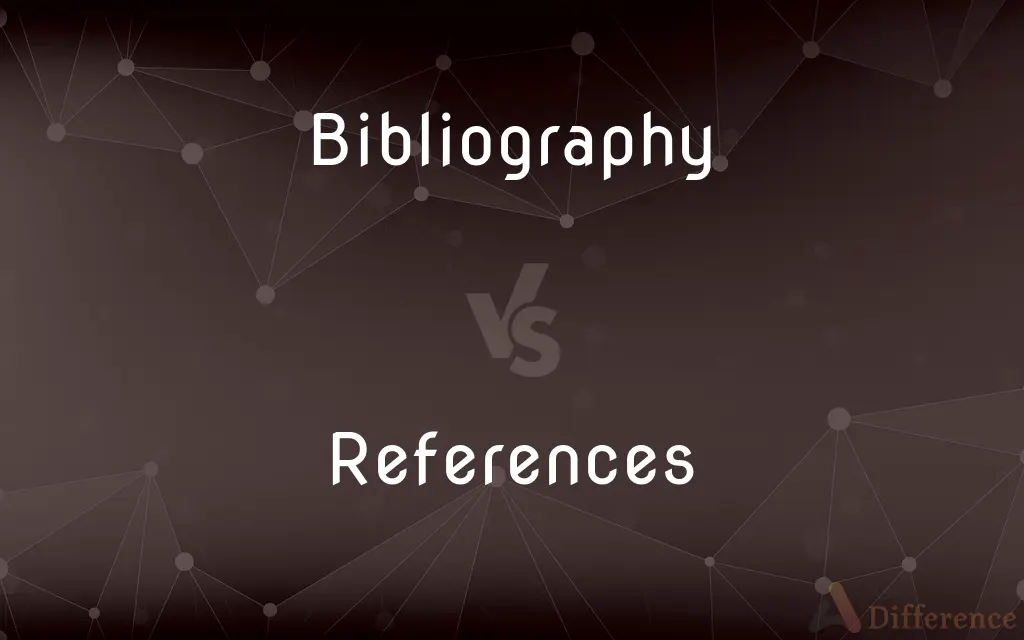Bibliography vs. References — What's the Difference?
Edited by Tayyaba Rehman — By Fiza Rafique — Published on December 4, 2023
Bibliography lists all materials consulted, while References only include cited works. Both aid readers in locating sources.

Difference Between Bibliography and References
Table of Contents
ADVERTISEMENT
Key Differences
Bibliography and References are terms used in academic writing to guide readers to external sources. A Bibliography encompasses every material the author consulted during their research, regardless of whether these materials were directly cited in the work. References, on the other hand, strictly contain the list of sources that were directly mentioned or cited within the document.
In the context of a research paper or thesis, a Bibliography serves as a comprehensive record, allowing readers to delve deeper into the topic by exploring all materials the author deemed relevant. Contrarily, References serve as a direct testament to the author's claims, pinpointing the exact sources of particular data, quotations, or ideas. This distinction between Bibliography and References ensures the reader's ability to verify claims and explore further materials.
Authors often opt for a Bibliography when they wish to showcase the breadth of their research, even if some sources didn't make it into the final paper. In contrast, when they use References, they're narrowing down to the primary influences and data points that shaped their argument or findings. Both Bibliography and References enhance the credibility of a document, but they serve slightly different purposes.
It's essential for writers to differentiate between Bibliography and References, especially when following specific formatting styles like APA, MLA, or Chicago. Different academic disciplines or publications might prefer one over the other, but understanding the distinction ensures accurate and effective communication of research.
Comparison Chart
Definition
List of all materials consulted
List of materials directly cited
ADVERTISEMENT
Purpose
Showcase breadth of research
Verify claims and pinpoint exact sources
Inclusion
Cited and uncited sources
Only cited sources
Format
Varies by style (APA, MLA, etc.)
Specific to citation style (APA, MLA, etc.)
Example
A list of all books read on a topic
A list of books/articles quoted or paraphrased in a paper
Compare with Definitions
Bibliography
A comprehensive list of materials consulted in research.
His Bibliography included every book he read while preparing his thesis.
References
Directly quoted or influenced portions of a document.
Each claim in the article was backed up by the listed References.
Bibliography
A list detailing sources for further reading.
Readers can refer to the Bibliography to explore the topic in depth.
References
A record of sources supporting claims or data in a work.
The References section included various reputable journals.
Bibliography
An aggregation of sources, both cited and uncited.
The Bibliography at the end of her essay showcased her thorough research.
References
A list of sources directly cited in a document.
She double-checked her References to ensure every citation was accurate.
Bibliography
All resources an author consulted, regardless of citation.
Her Bibliography was diverse, containing books, articles, and interviews.
References
Materials mentioned or paraphrased in a text.
His essay had over thirty References, reflecting the depth of his research.
Bibliography
A record of materials relevant to a topic or research.
The extensive Bibliography demonstrated the author's dedication to the subject.
References
The act of referring to something
Filed away the article for future reference.
Bibliography
A list of the works of a specific author or publisher.
References
Significance for a specified matter; relation or relationship
Her speeches have special reference to environmental policy.
Bibliography
A list of writings relating to a given subject
A bibliography of Latin American history.
References
Meaning or denotation
The reference of the word “lion” is to a kind of wild cat.
Bibliography
A list of writings used or considered by an author in preparing a particular work.
References
A mention of an occurrence or situation
Made frequent references to her promotion.
Bibliography
The description and identification of the editions, dates of issue, authorship, and typography of books or other written material.
References
A note in a publication referring the reader to another passage or source.
Bibliography
A compilation of such information.
References
The passage or source so referred to.
Bibliography
A section of a written work containing citations, not quotations, to all the books referred to in the work.
References
A work frequently used as a source.
Bibliography
A list of books or documents relevant to a particular subject or author.
References
A mark or footnote used to direct a reader elsewhere for additional information.
Bibliography
The study of the history of books in terms of their classification, printing and publication.
References
Submission of a case to a referee.
Bibliography
A history or description of books and manuscripts, with notices of the different editions, the times when they were printed, etc.
References
Legal proceedings conducted before or by a referee.
Bibliography
A list of books or other printed works having some common theme, such as topic, period, author, or publisher.
References
A person who recommends another or who can vouch for another's fitness or qualifications, as for a job.
Bibliography
A list of the published (and sometimes unpublished) sources of information referred to in a scholarly discourse or other text, or used as reference materials for its preparation.
References
A statement about a person's qualifications, character, and dependability.
Bibliography
The branch of library science dealing with the history and classification of books and other published materials.
References
To supply (a text) with references
The author hadn't adequately referenced the third chapter, so the copyeditor suggested adding more citations. This article is thoroughly referenced with up-to-date sources.
Bibliography
A list of writings with time and place of publication (such as the writings of a single author or the works referred to in preparing a document etc.)
References
To cite as a reference
The monograph doesn't reference any peer-reviewed articles.
References
Usage Problem To mention or allude to
The comedian's monologue referenced many Hollywood stars.
References
Plural of reference
References
A collection of materials that shaped a paper or study.
She meticulously compiled her References, ensuring each source was credited.
Common Curiosities
Is a Bibliography broader than References?
Yes, a Bibliography includes all materials, whether cited or not, making it broader.
What's the primary distinction between Bibliography and References?
Bibliography lists all materials consulted, while References only list cited works.
Is it mandatory to include a Bibliography in a research paper?
No, it's not always mandatory, but it's recommended if the author consulted numerous resources.
Are Bibliography and References style-specific?
Yes, different citation styles (e.g., APA, MLA) have specific formats for both.
Do all academic papers need a References section?
Generally, yes. Any paper that cites external sources should have a References section.
Why are References important in academic writing?
References validate claims, allowing readers to verify information and trace sources.
How detailed should a References section be?
It should provide enough detail for readers to locate and access the original sources.
Can Bibliography and References overlap?
Yes, all items in References might appear in a Bibliography, but not necessarily vice versa.
Can a document have both Bibliography and References sections?
Yes, some documents feature both to differentiate between all sources consulted and those directly cited.
Can a Bibliography include uncited materials?
Yes, Bibliographies encompass all materials the author consulted, cited or not.
Does every citation in a paper appear in the References?
Yes, every cited source in a paper should appear in the References.
Which is more common in academic journals, Bibliography or References?
References are more common, but the preference can vary by discipline or journal.
Can websites be included in a Bibliography or References?
Absolutely, both can include websites, provided they are relevant and credible.
Do Bibliographies rank or categorize sources?
Typically, no. Bibliographies usually list sources alphabetically or in the order of citation.
Why is it essential to differentiate between the two?
Differentiating ensures accurate communication of research and aids readers in locating relevant sources.
Share Your Discovery

Previous Comparison
Fixed Cost vs. Variable Cost
Next Comparison
Research Proposal vs. Research ReportAuthor Spotlight
Written by
Fiza RafiqueFiza Rafique is a skilled content writer at AskDifference.com, where she meticulously refines and enhances written pieces. Drawing from her vast editorial expertise, Fiza ensures clarity, accuracy, and precision in every article. Passionate about language, she continually seeks to elevate the quality of content for readers worldwide.
Edited by
Tayyaba RehmanTayyaba Rehman is a distinguished writer, currently serving as a primary contributor to askdifference.com. As a researcher in semantics and etymology, Tayyaba's passion for the complexity of languages and their distinctions has found a perfect home on the platform. Tayyaba delves into the intricacies of language, distinguishing between commonly confused words and phrases, thereby providing clarity for readers worldwide.














































